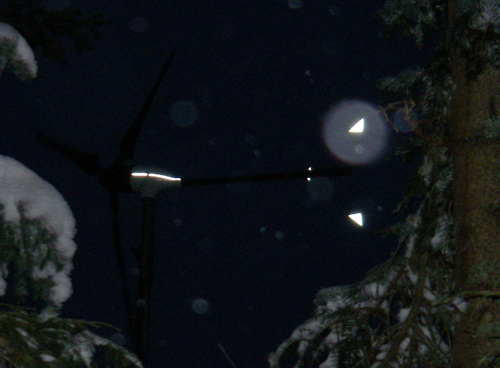Generating our own power means monitoring the equipment, particularly the wind generator. Like any piece of machinery, it operates within certain limits: it will not generate power with too little wind, nor will it survive too much wind. Our wind generator is built to withstand very high winds. In gusts of 35 knots or so, it is designed to “feather,” pivoting to set the prop at right angles to the wind to reduce strain. When braking the generator, we watch to ensure that the prop isn’t feathering. This is pretty difficult when it’s dark. I’ve made it easier by adding reflectors to the generator.

Reflectors make the generator "pop" in darkness and low light. Horizontal stripe means the wind's from the north, straight line means no "feathering." (Photo: Mark Zeiger.)
I purchased a length of reflective adhesive tape, the kind used on personal flotation devices—life preservers—because its adhesive is very strong and weather resistant.
At first, I cut small dots and put them on the tips of the generator blades, front and back. I took pains to make them all the same size, and to place them evenly, even though it’s not very likely that their slight weight would disturb the prop balance.
The result of this simple operation was dramatic: with the flick of a flashlight, we could see the ghostly circle of reflected light in the darkness slow to distinct dots as the brake engaged. Our frustrating guessing game ended, thanks to a few reflective stickers.
Unfortunately, the adhesive didn’t adhere well to the blades’ slick composite material. Within a month or so, all the stickers fell off.
The next time I had the generator down, I went a step further, putting “war paint” on the generator itself. I put very narrow strips of reflector on each side of the generator body. On the port side, I made a horizontal line that crossed the gap between the two halves of the body, that swing away from each other on a pivot when the machine feathers. On the starboard side, I made a vertical line across the gap.
Now, we can see which way the wind blows at a glance. If we see an illuminated horizontal line from the cabin, we know the wind’s from the north. If we see a vertical line, we know it’s from the south. If either line is broken and the sections are perpendicular to each other, we know that the machine is feathering.
I augmented this with a few triangle reflectors on the tailfin. I reinstalled reflectors on the prop tips, but they eventually fell off again. I plan to make reflector “washers” and pin them to the base of the prop on both sides with the bolts that hold the blades on. This final step should allow me to monitor the prop itself once again.
